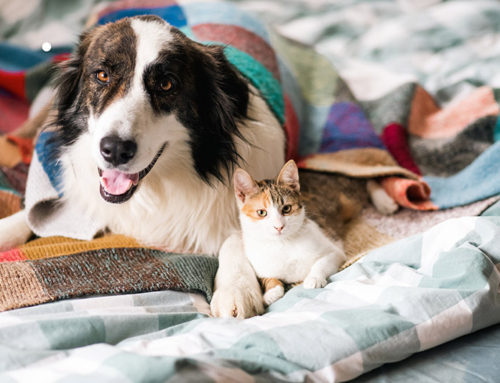THE SINGLE MOST IMPORTANT DECISION YOU CAN MAKE FOR YOUR CAT OR DOG IS TO SPAY OR NEUTER THEM
• Spaying (for the females) or neutering (for the males) effectively eliminates the development and progression of numerous objectionable and sometimes dangerous sexual behaviors.
• Most people think veterinarians recommend spaying and neutering to help the overpopulation crisis. Tragically, about every four seconds an animal is killed by euthanasia because it has no home. While this is certainly a major reason to spay or neuter your pet, there are numerous health and behavioral benefits, too.
• Spaying or neutering your pet eliminates or reduces a wide variety of health problems that can be very difficult and expensive to treat, such as many types of cancer, tumors, and other serious health complications.
• Spayed and neutered animals no longer feel the need to roam seeking a mate, so they have less chance of being involved in fights or traumatic injuries.
• Infections, abscesses, diseases such as feline leukemia virus and feline AIDS (transmitted by fighting), and other contagious diseases are greatly reduced in altered cats, which helps avoid expensive vet bills while extending their life span.
• After euthanasia, cancer is the number-one killer of cats and dogs. Yet a onetime surgery can prevent most of these deaths. I can’t tell you how many times devastated owners have said to me, “Nobody ever told me about the health risks of not spaying or neutering my pet.”
• Spaying or neutering your cat or dog leads to better health, longer life, peace of mind, and foolproof birth control that lasts a lifetime.
• The average life span of an altered pet is 40% longer than one that’s not spayed or neutered, and the overall effects of spaying or neutering will positively influence your pet’s behavior.
• For every heat cycle a female pet endures, her odds of having medical problems later multiply by ten.
• Dogs in heat have been known to run through glass doors, jump out of moving cars, and be hit by cars as they attempt to find a mate.
• Spaying your dog before her first heat cycle (usually at six to seven months of age) will decrease her chance of developing breast cancer to almost zero.
• Infections of the uterus called pyometra are very common and life-threatening in unspayed females.
• Animals in heat and pregnant animals can also be spayed.
• Puppies can become pregnant as young as six months of age and kittens as young as four months.
• Breast cancer, the silent killer of thousands of American women, is the most common malignant tumor in dogs and the third most common cancer in cats.
• Breast cancer is more common in dogs than humans with a prevalence of four times that seen in women.
• The chance of an unspayed female dog reaching 10 years of age without developing this potentially fatal disease is less than 11% in some breeds.
• More than 25% of unspayed female dogs will develop a mammary tumor during their lifetime.
• Dogs and cats have their own sexually transmitted disease, many fatal and some potentially contagious to humans but spayed pets are rarely exposed to these diseases
• Dogs and cats that are neutered live an average of 40% longer than dogs and cats that aren’t neutered.
• About ninety percent of the millions of cats and eighty percent of the dogs that get hit and killed by vehicles are unaltered males
• Some owners also fear that a male dog will be “less of a male,” act more like a female, or not be as tough or intelligent if neutered. Thankfully for dogs, cats, and men, the reproductive organs do not control their intelligence level or their toughness, loyalty, or character.
• More than eighty percent of all unaltered dogs develop prostate disease.
• Neutered males have a ninety percent reduction in roaming, which leads to dogfights, hit by car and illness.
Unspayed female dogs and cats are at risk for developing a number of medical problems such as:
• Ovarian cancer
• Uterine cancer
• Cervical cancer
• Breast cancer
• Mastitis
• Uterine infections
• Uterine torsion and uterine prolapse
• Vaginal hyperplasia and prolapse
• Cystic endometrial hyperplasia
• Chronic endometritis
• Cystic ovaries and hyperestrogenism
• False pregnancies
• Difficult pregnancies
• Transmissible venereal sarcoma
• Skin conditions
Neutering greatly decreases or completely eliminates certain health problems such as:
• Testicular cancer
• Testicular torsion
• Rectal cancer
• Benign prostatic hyperplasia
• Prostatic abscess
• Prostatic cancer
• Epididymitis (infection of the epididymis)
• Perineal hernia (abdominal organs bulging out of rectum)
• Inguinal hernia with potential organ strangulation
• Perianal gland adenomas
• Orchitis (infection of the testicles)
• Venereal tumors
• Acute or chronic prostatitis
EARLY-AGE SPAYING OR NEUTERING
• Pediatric spaying and neutering (sterilizing pets between eight and 14 weeks of age) has been practiced in North America for more than 30 years to help control the pet overpopulation epidemic.
• Numerous studies have shown pediatric spay and neuter to be not only safe but that younger puppies or kittens actually do better with the appropriate anesthesia as well as the surgical process.
• Those neutered at a very young age often have less bleeding and faster recoveries than those neutered when they are older.
• Early spaying or neutering does not affect the growth rate and there are no appreciable differences in skeletal, physical, or behavioral development between those animals spayed or neutered early versus those spayed at six months.





